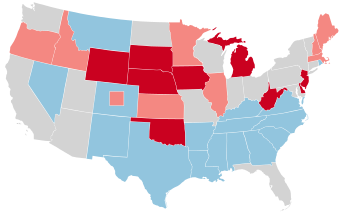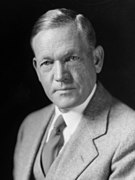| ||||||||||||||||||||||||||||||||||||||||||||||||||||||||||||||||||||
34 of the 96 seats in the United States Senate 49 seats needed for a majority | ||||||||||||||||||||||||||||||||||||||||||||||||||||||||||||||||||||
|---|---|---|---|---|---|---|---|---|---|---|---|---|---|---|---|---|---|---|---|---|---|---|---|---|---|---|---|---|---|---|---|---|---|---|---|---|---|---|---|---|---|---|---|---|---|---|---|---|---|---|---|---|---|---|---|---|---|---|---|---|---|---|---|---|---|---|---|---|
| ||||||||||||||||||||||||||||||||||||||||||||||||||||||||||||||||||||
 Results of the elections: Democratic hold Republican gain Republican hold No election Rectangular inset (Colorado): both seats up for election | ||||||||||||||||||||||||||||||||||||||||||||||||||||||||||||||||||||
| ||||||||||||||||||||||||||||||||||||||||||||||||||||||||||||||||||||
The 1942 United States Senate elections were held November 3, 1942, midway through Franklin D. Roosevelt's third term as president. The 32 seats of Class 2 were contested in regular elections, and two special elections were held to fill vacancies.
Although this election took place during World War II, the opposition Republican party made major gains, taking eight seats from the Democrats and one from an independent. The Democrats nonetheless retained a significant majority, though the smallest since Roosevelt was first elected in 1932.
The New York Times ascribed the results to "voters' dissatisfaction with the conduct of the war, both at home and abroad" but not evidence of a lack of enthusiasm for the war effort. It found that a candidate's stance as isolationist or interventionist before Pearl Harbor had little impact on his success at the polls.[3] The paper's editorial board welcomed a return to normal political alignments after the unbalanced majorities of the previous decade.[4] The election not only changed the numbers of Democrats and Republicans in the Senate, but also accomplished an ideological shift, as several longtime enthusiastic supporters of the New Deal were replaced by Republicans of the most conservative sort.[5]
The Republicans gained enough seats to end the Democrats' supermajority control.[6] Democrats later gained a seat in New Jersey through an appointment, bringing their seat total up to 58.
- ^ There was a regular election September 14, 1942 in Maine.
- ^ a b c Cite error: The named reference
Clerkwas invoked but never defined (see the help page). - ^ Lawrence, W.H. (November 5, 1942). "Margin is Narrow" (PDF). The New York Times. Retrieved February 25, 2017.
- ^ "The New Congress" (PDF). The New York Times. November 5, 2017. Retrieved February 25, 2017.
- ^ Malsberger, John W. (2000). From Obstruction to Moderation: The Transformation of Senate Conservatism, 1938-1952. Susquehanna University Press. p. 100. ISBN 9781575910260. Retrieved February 25, 2017.
- ^ Murphy, Paul (1974). Political Parties In American History, Volume 3, 1890-present. G. P. Putnam's Sons.
© MMXXIII Rich X Search. We shall prevail. All rights reserved. Rich X Search


